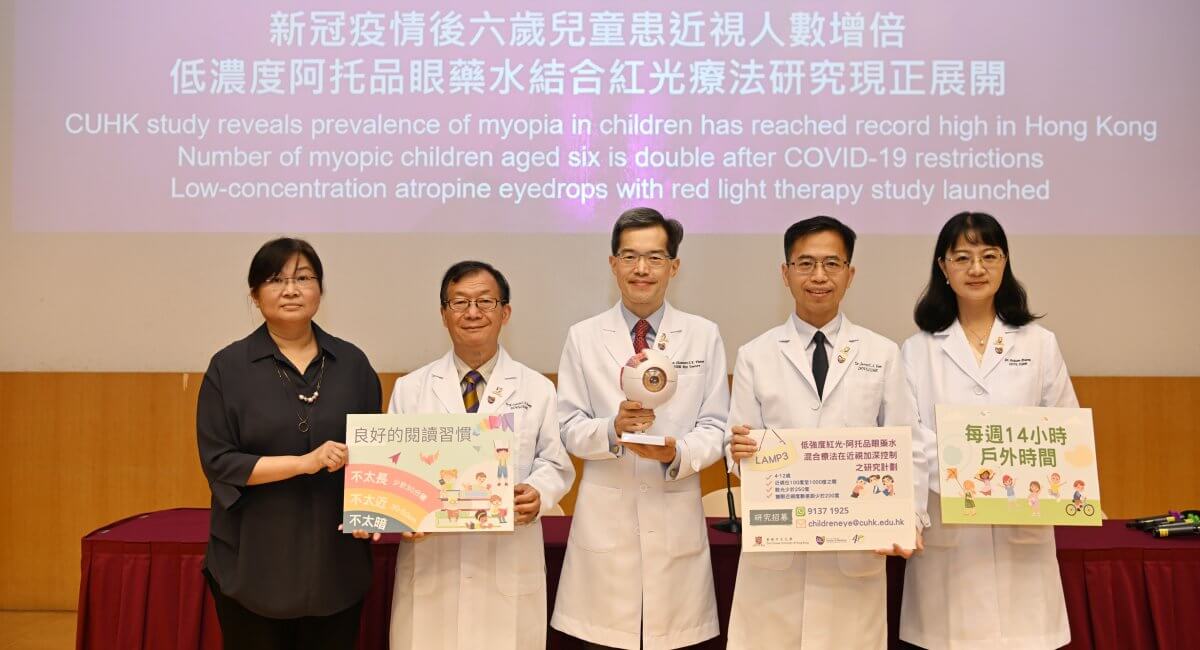In order to have a thorough evaluation on the impact of COVID-19 restrictions on myopia prevalence in children and its lingering effect after the city returned to normal, The Chinese University of Hong Kong (CUHK)’s Faculty of Medicine (CU Medicine) research team conducted a population-based study looking at the myopia prevalence of children aged six to eight, covering the periods before, during and after COVID-19 restrictions. Results showed the prevalence of myopia in young school children in Hong Kong has reached a record high after the lifting of pandemic rules, with the rate doubling in children aged six. Experts expect myopia prevalence in Hong Kong children to remain high over the next few years. Findings have been published in the international journal JAMA Network Open.
Myopia boom observed during COVID-19 pandemic

Myopia is the most common ocular disease worldwide and is responsible for multiple ocular complications which carry a high risk of irreversible vision loss later in life due to excessive eyeball growth.
The CU Medicine research team reported in 2021 that the COVID-19 pandemic has triggered a “myopia boom” in school children. “Under the COVID-19 restrictions, school children were spending significantly less time outdoors and more time on near work. These two behaviours are associated with myopia development and progression. In the previous study, we observed a rise in myopia incidence during the pandemic, but what concerns us more is the long-term effects on children’s eye health,” said Prof Clement CY THAM, Chairman and S H Ho Professor of Ophthalmology and Visual Sciences from the Department of Ophthalmology and Visual Sciences at CU Medicine.
Myopia prevalence in children expected to remain high over the next few years
The research team recruited 20,527 children aged six to eight through the Department’s ongoing Hong Kong Children Eye Study, analysing their myopia prevalence over seven consecutive years (2015-2021) that cover three periods: before the COVID-19 pandemic, during COVID-19 restrictions, and after COVID-19 restrictions. Study data include dioptres, axial length, and questionnaires on the amount of time they spent outdoors, on screens and doing near work.
Results showed the myopia prevalence in children aged six to eight increased by half on average after the pandemic restrictions were lifted, to a record high of 36%. And more alarmingly, the study found the prevalence doubled in younger children aged 6 (see details in Table 1 of appendix).

Prof Calvin CP PANG, S H Ho Research Professor of Visual Sciences from the Department of Ophthalmology and Visual Sciences at CU Medicine, and Director of the Joint Shantou International Eye Centre of Shantou University and The Chinese University of Hong Kong, remarked, “Myopia is irreversible once it has developed. The earlier its onset, the greater the likelihood of high myopia occurring later in life, increasing the risk of developing myopia-related pathology and blindness. Complications of high myopia include glaucoma, macular degeneration, cataracts and retinal detachment. The doubled myopia prevalence found in younger children in this study causes concern about future increases in the rate of myopia.”

Dr ZHANG Xiujuan, Research Assistant Professor from the Department of Ophthalmology and Visual Sciences at CU Medicine, said, “Parental myopia is known as one of the strongest factors associated with childhood myopia. But in this study, children with both parents without myopia were also seen to develop myopia to a larger extent than before the pandemic. Younger children and those from low-income families were at a higher risk of myopia developing during the pandemic. Our data showed children’s lifestyles, including outdoor time, near-work time and screen time, did not return to pre-COVID-19 levels after face-to-face lessons resumed. Myopia prevalence may remain high over the next few years.”

Dr Jason CS YAM, Associate Professor from the Department of Ophthalmology and Visual Sciences, CU Medicine, and Director of the CUHK Jockey Club Myopia Prevention Programme, concluded, “We recommend schoolchildren increase outdoor time and that parents and teachers help children develop healthy habits in using digital devices. It is also crucial to adopt interventions that can help manage myopia development and progression in young children. Our team has launched a study to investigate the efficacy and safety of combining low-concentration atropine eyedrops with red light therapy on young children aged four to 12.”



Interested individuals can contact the research team by WhatsApp (91371925) or email (childreneye@cuhk.edu.hk).

Appendix
Table 1: Annual myopia prevalence of children aged six to eight before, during and after pandemic restrictions.
| Annual myopia prevalence before COVID-19 pandemic (2015 to 2019) |
Annual myopia prevalence during COVID-19 restrictions (January 2020 to February 2021) |
Annual myopia prevalence after COVID-19 restrictions (March to December 2021) |
|
| Overall (Age six to eight) | 23.8% | 28.8% | 36.2% |
| Age six | 13.9% | 18.5% | 25.2% |
| Age seven | 25.8% | 30.4% | 34.1% |
| Age eight | 37.3% | 42.1% | 46% |
2023年8月30日
中大研究發現香港兒童近視率創新高
新冠疫情後六歲兒童患近視人數倍增
低濃度阿托品眼藥水結合紅光療法研究現正展開
為全面評估新冠防疫措施對本港兒童患近視比率的影響及復常後的情況,中大醫學院團隊進行了一項以人口為基礎的研究,了解及分析六至八歲兒童在新冠爆發前、新冠防疫措施生效期間及開始復常後的近視率變化。研究結果顯示,香港年幼學童在經歷一年多的防疫措施後,患近視人數達歷史新高,六歲兒童的近視率更加倍增。專家預計在未來數年,本港兒童的近視率將維持較高水平。研究結果已經在國際期刊《JAMA Network Open》發表。
新冠疫情期間現「近視爆發潮」
近視是全球最常見的眼疾,成因是眼球過度生長,導致不能看清遠距離的物體,嚴重者可引發多種致盲併發症。
中大醫學院研究團隊早於2021年發表研究,揭示本港學童於新冠疫情期間出現「近視爆發式增長」。中大醫學院眼科及視覺科學學系系主任兼何善衡眼科及視覺科學講座教授譚智勇教授表示:「在新冠防疫措施實行期間,學童大幅減少戶外活動,而用更多時間於近距離的工作上,這兩種行為與近視的發展和加深極為相關。在早前的研究中,我們觀察到疫情期間近視發病率上升,但更令我們關注的是對兒童眼睛健康的長遠影響。」
預計港童近視率於未來數年持續高企
研究團隊從其「香港兒童眼科計劃」中收集20,527名六至八歲兒童的數據進行分析,探討他們在2015年至2021年間的近視率變化,覆蓋新冠爆發前、防疫措施實行及面授課堂暫停期間,以及防疫措施放寬並恢復面授課堂後的三個研究時期。研究數據包括屈光度、眼軸長度,以及了解他們參與戶外活動、觀看電子螢幕及近距離工作時間的調查問卷。
結果顯示,在防疫措施放寬後,本港六至八歲兒童患近視的比率較疫情前上升五成,而六歲兒童的近視率更增加一倍。(詳見附件表一)
中大醫學院眼科及視覺科學學系何善衡視覺科學研究講座教授兼汕頭大學・香港中文大學聯合汕頭國際眼科中心院長彭智培教授表示:「近視一旦出現就不能逆轉,而且愈早發病,往後出現深近視問題的可能性就愈大,亦會增加罹患包括青光眼、黃斑病變、白內障和視網膜脫落等與深近視相關併發症的風險。這些疾病都可導致嚴重視力障礙,甚至致盲。此研究發現本港年幼兒童的近視患病率增加一倍,令人擔心未來的近視率會繼而增加。」
中大醫學院眼科及視覺科學學系研究助理教授張秀娟博士表示:「父母近視一直是兒童近視的最主要因素之一。但我們的研究發現,即使父母雙方均沒有近視,其孩子患近視的比例亦較新冠疫情前高。另一方面,年幼兒童和低收入家庭的兒童在疫情下,患近視的風險較其他兒童高。我們的數據顯示,在恢復面授課堂後,兒童的生活方式包括戶外活動、近距離工作和使用電子屏幕的時間,並未回復到新冠疫情前的水平。我們預視未來數年,香港兒童的近視患病率可能持續高企。」
中大醫學院眼科及視覺科學學系副教授兼「香港中文大學賽馬會瞳心童行計劃」總監任卓昇醫生總結:「我們建議學童增加戶外活動時間,家長和老師應幫助他們養成健康的電子產品使用習慣。另外,接受有助於控制兒童近視發展和加深的治療也同樣重要。我們的團隊已開展了一項研究,探討低濃度阿托品眼藥水結合紅光療法對四至12歲兒童控制近視的成效和安全性。」
有興趣人士可以WhatsApp (91371925) 或電郵(childreneye@cuhk.edu.hk)聯繫研究團隊。
附件
表一: 本港六至八歲兒童在「新冠爆發前」、「新冠防疫措施實行期間」及「新冠防疫措施放寬後」三個時段的每年近視率:
| 新冠爆發前 每年近視率 (2015至2019年) |
新冠防疫措施實行期間每年近視率 (2020年1月至2021年2月) |
新冠防疫措施放寬後 每年近視率 (2021年3月至同年12月) |
|
| 整體 (六至八歲) | 23.8% | 28.8% | 36.2% |
| 六歲 | 13.9% | 18.5% | 25.2% |
| 七歲 | 25.8% | 30.4% | 34.1% |
| 八歲 | 37.3% | 42.1% | 46% |


 Creative Commons Attribution
Creative Commons Attribution